Fossil mycoparasite like extant Trichoderma (3)
Since the mycoparasite Trichoderma, which
is of agricultural
relevance, has never been found as a fossil [1], it
seems appropriate to present more pictures
from the Rhynie chert, in
addition to the previously presented ones [2],
of a Lower Devonian fungus similar to the extant parasite.
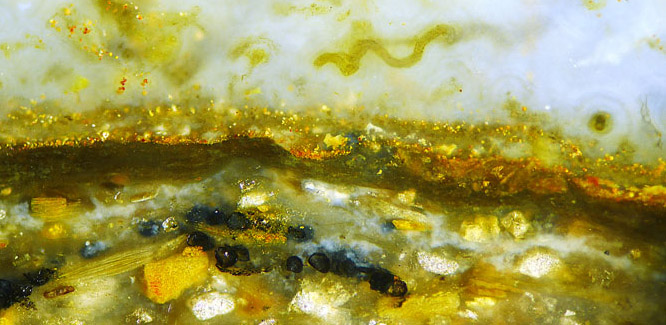

Fig.1 (left): Undulating hypha grown in water, possibly contacting a
thinner one, all silicified together with the bottom below.
Image width 2mm.
Fig.2: Irregularly curled
branching hypha; straight branching hypha above.
Image width 1.5mm.
Fungus hyphae seen in the
Rhynie chert are most often unexpectedly
straight, a feature apparently not only due to growing in water but to
some not yet known reason. Hence, a
few wavy hyphae among lots of (partially) straight
ones are
conspicuous. Undulating
hyphae growing along straight ones did not arouse attention as fossils
[3] until the striking similarity to the extant parasitic fungus Trichoderma was
noticed in 2017 [2]. Their aspect may vary between wavy in a more
or less regular way as in Fig.1, curly as in Figs.2-4, or fuzzy with
small wavy and curly components as in
Figs.5,6.
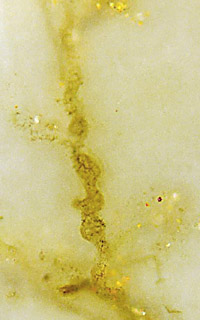
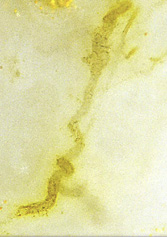
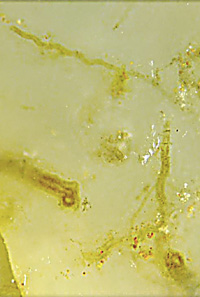
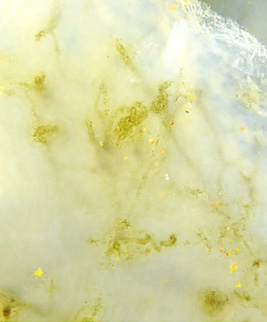
Figs.3,4 (left): Curly hyphae beset
with microbes seen as tiny dark dots. Image widths 0.6mm, 0.5mm.
Figs.5,6: Hyphae of fuzzy aspect with wavy or curly parts.
Image widths 0.6mm,
0.8mm.
All pictures of same scale. Taken by J. Gardavsky.
The straight hyphae which the parasite had preyed upon are most often
no more seen, probably owing to decay.
Several
details not related to parasitism are also offered by Fig.1. It
provides a rare view not only of the water where the fungi had grown
but also of the soil beneath with mineral debris and organic residues.
Two of the mineral grains on the left can be identified as stacks of
mica platelets. The black objects are most probably Aglaophyton
spores. The dark layer seems to be dead microbes. A cross-section
of a twice coated hypha is seen in the water on the
right.
Sample: Rh2/4, obtained from Shanks in
1998, cut into 4 parts, Part2 returned. Part1 (slab, given to J. Gardavsky):
Figs.2,3,6; Part3 (slab, in the own
collection): Figs.1,4,5.
H.-J.
Weiss 2019
[1] C.P. Kubicek:
Comparative genome sequence analysis underscores mycoparasitism as the
ancestral life style of Trichoderma.
Genome Biol. 2011; 12(4): R40.
[2] H.-J.
Weiss: www.chertnews.de,
Rhynie Chert News 109, 111.
[3] T.N.
Taylor, M. Krings,
E.L. Taylor: Fossil Fungi,
Elsevier 2015, p.251.
 |
 |
148 |









